
Íslenski hesturinn
- Hem
- Vårt arbete
- Husdjur
- Nordiska lantrasdjur
- Íslenski hesturinn
Origin: Iceland
English name: Icelandic horse
Weight: 350-400 kg
Height: 140 cm (average)
Colour: Multiple colours and patterns
Type: Leisure riding and sport competitons
Number of offspring: 1-2 (occures but rarely)
Birth weight: 45 kg
Number of horses in Iceland 2019: 78.000
Number in other countries 2019: 195.000
Not at Risk – Vulnerable – Enangered – Critically Endangered – Extinct
History:
The Icelandic horse breed has developed from ponies taken to Iceland by Norse settlers in the 9th and 10th centuries. The closest relatives seem to be the Norwegian Fjord, the Faroe Islands horse and the Shetland pony.
Considering the value of horses for transportation as well as the long journey across the Atlantic Ocean on small ships, it is likely that the settlers picked strong and sturdy individuals to fund their future herds. For centuries the horse was the primary means of transport in Iceland. The harsh weather conditions have without a doubt substantially shaped the stock.
Since the 19th century the Icelandic horse served well as a draught horse and was bred as such until tractor power took over by the middle of the 20th century and the number of horses decreased considerably. Organized breeding programmes began in Iceland early in the last century when coordinated horse shows were established. Today it has become a highly popular riding and equestrian sport horse and selection is based on defined breeding goals. The most unique characteristics of the Icelandic horse are the great colour variation and its versatility with regards to gaiting ability; possessing five gaits; walk, trot, canter, tölt and pace. The smooth gait, tölt, has become a well-known quality symbol of the Icelandic horse, contributing a great deal to its popularity worldwide.
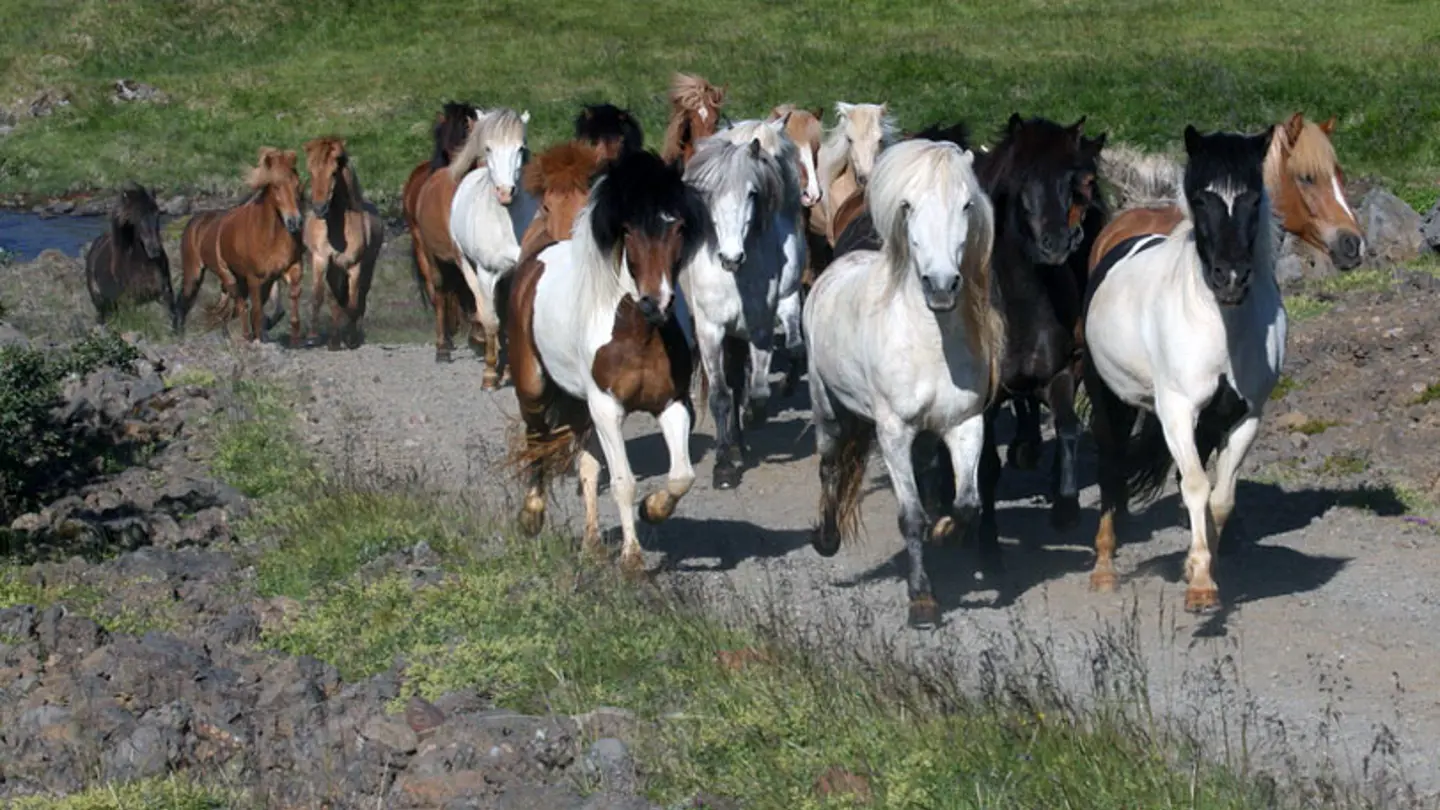
In recent decades the popularity of the Icelandic horse has increased steadily and export of riding horses has become an industry. The Icelandic horse can be found in most parts of the world and the International Federation of Icelandic Horse Associations (FEIF) has 22 member countries. The Farmers Association of Iceland (FAIC) and The Horse Breeding Association of Iceland (FHB) are responsible for the breeding work and set the official breeding goals covering health, fertility, colour variability, character, conformation and riding ability. Breeding fields tests, coordinated judgement of horses, as well as use of the BLUP system for the evaluation of breeding values, have always been the most important aspects of the implementation of the breeding programme. The BLUP method with animal model has been used for genetic evaluation of the Icelandic horse since 1986. Artificial insemination and embryo transfers have been used to a small extent in the most recent past. An international recording system and a database is operated by FAIC and FEIF (www.worldfengur.com) where horses of the Icelandic breed are registered worldwide, the database is available in nine languages. In WorldFengur you can find comprehensive information on around 450.000 Icelandic horses all around the world such as pedigree, offspring, pictures, videos, assessments, owners, breeders, BLUP, colours, DMTR3 „Gait keeper gene“, virtual mate selection, microchips and more. A regulation was issued in 2011 to support the recognition of Iceland as the country of origin of the Icelandic horse.
Characterization in research:
The Icelandic horse is a first glance one of the more characterized Nordic native breeds when looking through research. NordGen conducted a study showing up until 2019, 45 easily accessible studies were conducted. Many of the studies have focused on the DMRT3 “gait keeper gene”, but also responses to cold weather, temperament, colours, growth, performance, growth, cryptorchidism, summer exzema and SNPs association with pace performance has been described in at least one study. However, no studies focusing on the breed’s socio-cultural importance was found. Thus, there is still a need to continue and increase characterization of the Icelandic horse such that we are able to improve the basis of conservation decisions and thus conservation of the breed for future purposes.
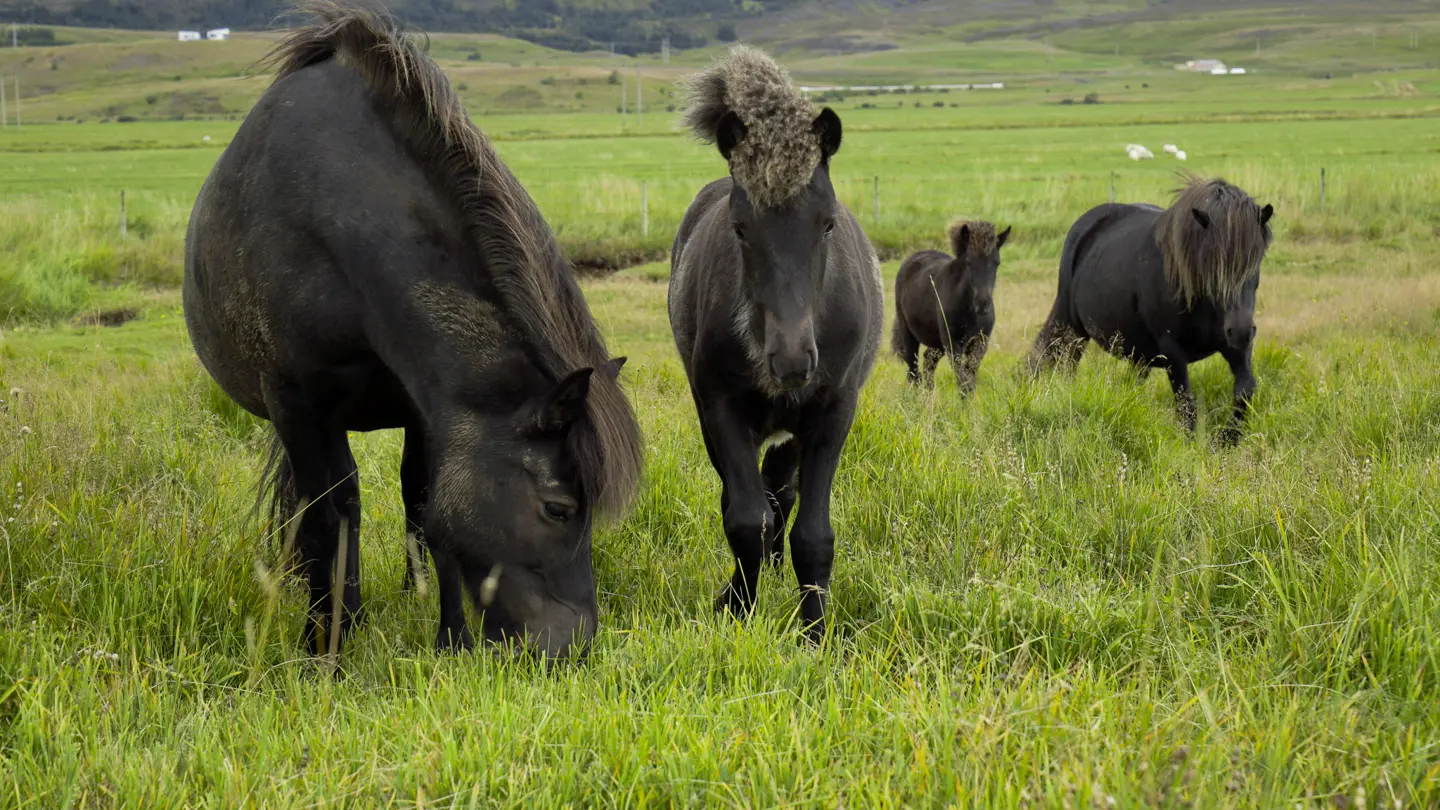
Referenser
Aberle, K. S. & Distl, O. (2004). Domestication of the horse: Results based on microsatellite and mitochondrial DNA markers. Archiv Für Tierzucht 47(6), 517–536.
Aberle, K. S., Hamann, H., Drögemüller, C. & Distl, O. (2004). Genetic diversity in German draught horse breeds compared with a group of primitive, riding and wild horses by means of microsatellite DNA markers. Animal Genetics 35(4), 270–277. doi:10.1111/j.1365-2052.2004.01166.x.
Adalsteinsson, S. (1981). Origin and conservation of farm animal populations in Iceland. Journal of Animal Breeding and Genetics, 98(1–4), 258–264. https://doi.org/10.1111/j.1439-0388.1981.tb00349.x
Albertsdóttir E., Árnason T., Eriksson S., Sigurdsson Á. & Fikse W.F. (2012). Effects of integrated genetic evaluations for Icelandic horses onpredictive ability, accuracy and selection bias. Journal of Animal Breeding and Genetics. 129, 41-49.
Albertsdóttir, E., Eriksson, S., Sigurdsson, Á. & Árnason, T. (2011). Genetic evaluation of 'breeding field test status' in Icelandic horses. Journal of Animal Breeding and Genetics. 128 (2) 124-132.
Andersson, L. S., Larhammar, M., Memic, F., Wootz, H., Schwochow, D., Rubin, C.-J., Patra, K., et al. (2012). Mutations in DMRT3 affect locomotion in horses and spinal circuit function in mice. Nature 488(7413), 642–646. doi:10.1038/nature11399.
Árnason, T. & Bjarnason, T. (1994). Growth, development and size of Icelandic toelter horses. Icelandic Agricultural Sciences 8, 73–83.
Bjørnstad, G., Nilsen, NØ & Røed, K. H. (2003). Genetic relationship between Mongolian and Norwegian horses? Animal Genetics 34(1), 55–58.
Bjørnstad, G. & Røed, K. H. (2001). Breed demarcation and potential for breed allocation of Horses Assessed by microsatellite markers. Animal Genetics 32(2), 59–65.
Bjornstad, G. & Roed, K. H. (2002). Evaluation of factors affecting individual assignment precision using microsatellite data from horse breeds and simulated breed crosses. Animal Genetics 33(4), 264–270. doi:10.1046/j.1365-2052.2002.00868.x.
Björnsson G.B. & Sveinsson H.J. (2004). Íslenski hesturinn [The Icelandic horse]. Mál og Menning, Reykjavík 415p. [In Icelandic].
Brooks, S. A., Makvandi-Nejad, S., Chu, E., Allen, J. J., Streeter, C., Gu, E., McCleery, B., Murphy, B. A., Bellone, R. & Sutter, N. B. (2010). Morphological variation in the horse: Defining complex traits of body size and shape: Skeletal traits in the horse. Animal Genetics 41(December), 159–165. doi:10.1111/j.1365-2052.2010.02127.x.
Campana, M. G., Stock, F., Barrett, E., Benecke, N., Barker, G. W. W., Seetah, K. & Bower, M. A. (2012). Genetic stability in the Icelandic horse breed: genetic stability in the Icelandic horse breed. Animal Genetics 43(4), 447–449. doi:10.1111/j.1365-2052.2011.02266.x.
Conn, L. (2019). The role of polymorphisms of the MSTN, GRIN2B and DOCK8 genes in the performance of pace-racing Icelandic horses. Second cycle, A2E. January 29, available at: https://stud.epsilon.slu.se/14182/
Eriksson, S., Grandinson, K., Fikse, W. F., Lindberg, L., Mikko, S., Broström, H., Frey, R., Sundquist, M. & Lindgren, G. (2008). Genetic analysis of insect bite hypersensitivity (summer eczema) in Icelandic horses. Animal 2(03), doi:10.1017/S1751731107001413.
Eriksson, S., Jäderkvist, K., Dalin, A.-M., Axelsson, J. & Lindgren, G. (2015). Prevalence and genetic parameters for cryptorchidism in Swedish-born Icelandic horses. Livestock Science 180(October), 1–5. doi:10.1016/j.livsci.2015.06.022.
Fegraeus, K. J., Hirschberg, I., Árnason, T., Andersson, L., Velie, B. D., Andersson, L. S. & Lindgren, G. (2017a). To pace or not to pace: A pilot study of four- and five-gaited Icelandic horses homozygous for the DMRT3 “gait keeper” mutation. Animal Genetics 48(6), 694–697. doi:10.1111/age.12610.
François, L., Fegraeus, K. J., Eriksson, S., Andersson, L. S., Tesfayonas, Y. G., Viluma, A., Imsland, F., et al. (2016). Conformation traits and gaits in the Icelandic horse are associated with genetic variants in Myostatin (MSTN). Journal of Heredity 107(5), 431–437. doi:10.1093/jhered/esw031.
Haase, B., Jagannathan, V., Rieder, S. & Leeb, T. (2015). A novel KIT variant in an Icelandic horse with white-spotted coat colour. Animal Genetics 46(4), 466–466. doi:10.1111/age.12313.
Hallamaa, R. E. (2009). Characteristics of equine summer eczema with emphasis on differences between Finnhorses and Icelandic horses in a 11-year study. Acta Veterinaria Scandinavica 51, 29. doi:10.1186/1751-0147-51-29.
Hreiḥarsdóttir, G. E., Árnason, Þ, Svansson, V. & Hallsson, J. H. (2014). Analysis of the history and population structure of the Icelandic horse using pedigree data and DNA analyses. Icelandic Agricultural Sciences 27, 63–79.
Hugason, K. (1994). Breeding of Icelandic Toelter horses: An overview. Livestock Production Science 40(1), 21–29. doi:10.1016/0301-6226(94)90262-3.
Hyllmark, M.-L. (2014). Sammensetning Av Egenskaper Innen Temperament Hos Varmblods Ridehest, Islandshest Og Ponni. Norwegian University of Life Sciences, available at: https://brage.bibsys.no/xmlui/handle/11250/227027
Ingimar Sveinsson (2010). Hrossafræði Ingimars. Uppheimar, 334 p. ISBN 978-9979-659-84-6. [I Icelandic].
Jansen, T., Forster, P., Levine, M. A., Oelke, H., Hurles, M., Renfrew, C., Weber, J. & Olek, K. (2002). Mitochondrial DNA and the origins of the domestic horse. Proceedings of the National Academy of Sciences 99(16), 10905–10910.
Janzekovic, M. & Prisenk, J. (2017). Assessment of stress on horses through the salivary cortisol concentration. In B. Katalinic (ed.) DAAAM International Scientific Book (1st ed., 16:pp. 055–062). Vienna: DAAAM International. doi:10.2507/daaam.scibook.2017.05.
Jäderkvist, K., Holm, N., Imsland, F., Árnason, T., Andersson, L., Andersson, L. S. & Lindgren, G. (2015). The importance of the DMRT3 “gait keeper” mutation on riding traits and gaits in Standardbred and Icelandic horses. Livestock Science 176(June), 33–39. doi:10.1016/j.livsci.2015.03.025.
Jensen, R. B., Danielsen, S. H. & Tauson, A.-H. (2016). Body condition score, morphometric measurements and estimation of body weight in mature Icelandic horses in Denmark. Acta Veterinaria Scandinavica 58(1), 59. doi:10.1186/s13028-016-0240-5.
Johansson, M. K., Fegraeus, K. J., Lindgren, G. & Ekesten, B. (2017). The refractive state of the eye in Icelandic horses with the silver mutation. BMC Veterinary Research 13(1), 153. doi:10.1186/s12917-017-1059-7.
Kangas, N. (2013). Association of the DMRT3 nonsense mutation with pattern of Locomotin in five different horse breeds. Swedish University of Agricultural Sciences, available at: http://stud.epsilon.slu.se/5834/7/kangas_n_130704.pdf
Keeling, L. J., Bøe, K. E., Christensen, J. W., Hyyppä, S., Jansson, H., Jørgensen, G. H. M., Ladewig, J., et al. (2016). Injury incidence, reactivity and ease of handling of horses kept in groups: A matched case control study in four Nordic countries. Applied Animal Behaviour Science 185(December), 59–65. doi:10.1016/j.applanim.2016.10.006.
Kierkegaard, L.S., Groeneveld, L.F., Kettunen, A., Berg, P. (2020). The status and need for characterization of Nordic animal genetic resources, Acta Agriculturae Scandinavica, Section A — Animal Science, 69:1-2, 2-24, DOI: 10.1080/09064702.2020.1722216
Kristjansson, T., Bjornsdottir, S., Sigurdsson, A., Andersson, L. S., Lindgren, G., Helyar, S. J., Klonowski, A. M. & Arnason, T. (2014). The effect of the “gait keeper” mutation in the DMRT3 gene on gaiting ability in Icelandic horses. Journal of Animal Breeding and Genetics 131(6), 415–425. doi:10.1111/jbg.12112.
Kristjansson, T., Bjornsdottir, S., Sigurdsson, A., Crevier-Denoix, N., Pourcelot, P. & Arnason, T. (2013). Objective quantification of conformation of the Icelandic horse based on 3-D video morphometric measurements. Livestock Science 158(1–3), 12–23. doi:10.1016/j.livsci.2013.09.019.
Kristjansson, T., Bjornsdottir, S., Albertsdóttir, E., Sigurdsson, A., Pourcelot, P., Crevier-Denoix, N. & Arnason, T. (2016). Association of conformation and riding ability in Icelandic horses. Livestock Science 189(July), 91–101. doi:10.1016/j.livsci.2016.05.010.
Lindberg, L. (2006). A genetic study of summer eczema in Icelandic horses. Swedish University of Agricultural Sciences, available at: http://ex-epsilon.slu.se/1223/
Lindgren, G., Backström, N., Swinburne, J., Hellborg, L., Einarsson, A., Sandberg, K., Cothran, G., Vilà, C., Binns, M. & Ellegren, H. (2004). Limited number of patrilines in horse domestication. Nature Genetics 36(4), 335–336.
Mejdell, C. M. & Bøe, K. E. (2005). Responses to climatic variables of horses housed outdoors under Nordic winter conditions. Canadian Journal of Animal Science 85(3), 307–308.
Petersen, J. L., Mickelson, J. R., Cothran, E. G., Andersson, L. S., Axelsson, J., Bailey, E., Bannasch, D., et al. (2013a). Genetic diversity in the modern horse illustrated from genome-wide SNP data. Edited by Hans Ellegren. PLoS ONE 8(1), e54997. doi:10.1371/journal.pone.0054997.
Promerová, M., Andersson, L. S., Juras, R., Penedo, M. C. T., Reissmann, M., Tozaki, T., Bellone, R., et al. (2014). Worldwide frequency distribution of the “gait keeper” mutation in the DMRT3 gene. Animal Genetics 45(2), 274–282. doi:10.1111/age.12120.
Reglugerð um uppruna og ræktun íslenska hestsins 442/2011. https://www.reglugerd.is/reglugerdir/eftir-raduneytum/landbunadarraduneyti/nr/17553
Reynisson, G. (2017). Analysis of movement in pace and Tölt in the Icelandic horse. Master’s degree project, Faculty of Land and ANimal Resources, Agricultural University of Iceland, 64
Shrestha, M. (2017). Genetics of equine insect bite hypersensitivity and genetic diversity in horses. Swedish University of Agricultural Sciences and Wageningen University and Research.
Shrestha, M., Eriksson, S., Schurink, A., Andersson, L. S., Sundquist, M., Frey, R., Broström, H., Bergström, T., Ducro, B. & Lindgren, G. (2015). Genome-Wide association study of insect bite hypersensitivity in Swedish-born Icelandic horses. Journal of Heredity 106(4), 366–374. doi:10.1093/jhered/esv033.
Sigurðardóttir, H., Albertsdóttir, E. & Eriksson, S. (2017). Analysis of new temperament traits to better understand the trait spirit assessed in breeding field tests for Icelandic horses. Acta Agriculturae Scandinavica, Section A - Animal Science 67(1–2), 46–57. doi:10.1080/09064702.2017.1383507.
Staiger, E. A., Almén, M. S., Promerová, M., Brooks, S., Cothran, E. G., Imsland, F., Fegraeus, K. J., et al. (2017). The evolutionary history of the DMRT3 “gait keeper” haplotype. Animal Genetics 48(5), 551–559. doi:10.1111/age.12580.
Ussing, A. P. (2004). Bevaringsværdige Farver Hos Islandshesten. Ngh-Nytt, November 2004.
Velie, B. D., Jäderkvist, K., Imsland, F., Viluma, A., Andersson, L. S., Mikko, S., Eriksson, S. & Lindgren, G. (2015). Frequencies of polymorphisms in Myostatin vary in Icelandic horses according to the use of the horses. Animal Genetics 46(4), 467–468. doi:10.1111/age.12315.
Vila, C. (2001). Widespread origins of domestic horse lineages. Science 291(5503), 474–477. doi:10.1126/science.291.5503.474.
Viluma, A. (2012). Polymorphism in myostatin gene and athletic performance in Nordic horse breeds. Swedish University of Agricultural Sciences, available at: http://stud.epsilon.slu.se/id/file/2988345
Wulfsberg, J. V. (2010). Unique trotter: The Norwegian coldblooded horse. Thesis, Szent István University, available at: http://www.huveta.hu/handle/10832/246
Läs vidare om våra andra lantrasdjur
-
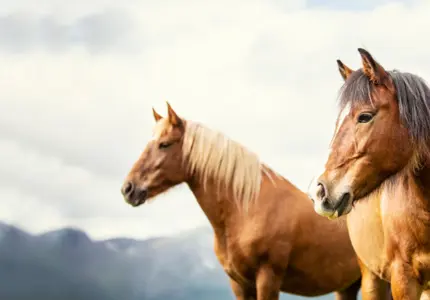
Nordlandshest/lyngshest
Den første, kjente og dokumenterte utstilling hvor denne rasen var stilt, var i 1898 på Lyngseidet i Troms. På 1930-tallet ble det satt i gang organisert avl av nordlandshest/lyngshest.
Läs mer om lantrasen
-
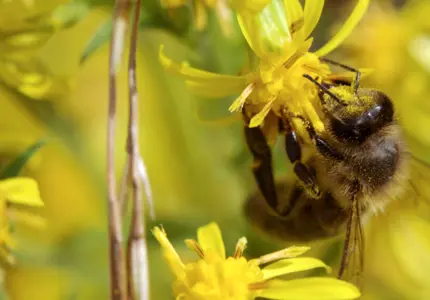
Den Nordiske Brunbia
Honningbier er truet av intensivt jordbruk, tap av habitat og klimaendringer over hele verden og er viktige å bevare, ikke bare på grunn av honningproduksjon, men også på grunn av deres pollineringstjenester.
Läs mer om lantrasen
-
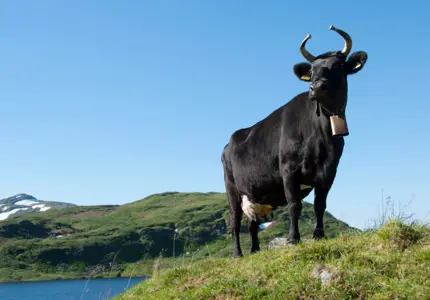
Dølafe
Dølafeet stammer opprinnelig fra Gudbrandsdalen, Østerdalen og Hedmarken. I områdene nord for Oslo var det store forekomster av næringsrike beiteområder, men det var langt til større byer for avsetning av melkeprodukter.
Läs mer om lantrasen